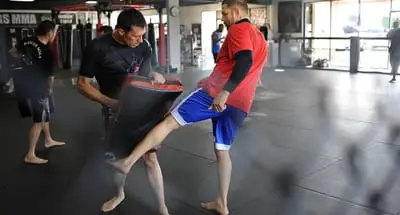
Kickboxing is a great workout for the whole body. A lot of people do it to lose weight and it’s really effective. Actually that is the most effective martial art/combat sport for losing weight and building lean muscle mass. But how many times a week should you do kickboxing in order to achieve your goals the fastest way possible?
How many times a week should you do kickboxing? Kickboxing is an aerobic workout so you can do it as many times a week as you can. Optimally 4 – 5 times a week (about an hour per each session) are enough to get the maximum and still have enough time for your body to recover.
If you are just starting and you are not in great shape yet you may feel sore after each workout. If that’s the case you won’t be able to workout 4 – 5 times a week. I would recommend starting with 3 (even 2 if you feel 3 is too much for you).
How many times you should train a week also depends on your goals. Above I assumed your goal is to lose weight; get in shape; build lean muscle mass (lean muscle, not toned). But you may want to build bigger muscles, to do kickboxing for self-defense or even competition.
In the rest of the article, I’ll cover how many times you should workout (and how) depending on your goals and also which days to work out, how to recover properly and avoid injuries – both really important things to consider if you want to progress steadily in the long run.
How Often and How to Workout Depending on Your Goals
Aerobic workout is great for building stamina and lean muscles but not so great if you want to increase your muscle mass. And as I said, kickboxing is considered an aerobic workout. But that doesn’t mean you can’t work out in a way to build muscle mass.
You just need to do more explosive movements while training (for example hitting the heavy bag less often but with full power instead of focusing on volume).
Also, you need to focus more on strength and conditioning. Normally I would suggest doing 80% technique workout (shadowboxing, heavy bag, sparring, etc) and 20% strength and conditioning (running, rope jumping, free bodyweight exercises – pull-ups, push-ups sit-ups; weight lifting).
If you want to build more muscle mass that percentage should be 60% technique and 40% strength and conditioning. And instead of doing running, better do sprints and also focus more on the weight lifting (basic exercises – deadlift, bench press, squat) instead of free bodyweight.
And if your goal is to lose weight and get lean muscles you should do the opposite – more endurance exercises instead of explosive power exercises – running, rope jumping, bag work, swimming, free bodyweight exercises. Also when doing shadow boxing and heavy bag focus on volume – a lot of punches and kicks and don’t worry about the power too much.
Workouts for building muscle mass are usually shorter than endurance-based workouts. For example 40 minutes vs 60 minutes depending on your goal. Also when doing anaerobic workouts you should do them fewer times a weak compared to aerobic so your muscles can recover. 3 – 4 times are enough.
How Often for Self-Defense and Competition
When you do kickboxing to compete or for self-defense, there is a big difference than if your goal is fitness. You still have to do strength and conditioning to build your athleticism but your main focus should be technique so you can use kickboxing effectively in the ring or on the street.
80% technique and 20% strength and conditioning as I said before. And you should train at least 5 times a week. 6 times if you want to compete (you have to have at least 1 day off) and even twice a day if you are in a training camp – when preparing for a fight.
Another big difference is that when you workout for fitness, doing full contact sparring isn’t necessary. You should be doing at least 2 times full contact sparring a week if you want to be able to use kickboxing effectively. It doesn’t have to be hard sparring but full-contact. That means you can punch/kick the body and the head with about 60-70% of your power.
Which Days of the Week to Workout
If you decide you’ll workout 5 times a week I don’t recommend going to the gym from Monday to Friday and resting during the weekend. Your body will recover much better if you, for example, rest on Sunday and Wednesday for example. Spread the rest days, don’t rest 2 days in a row if you workout 5 times a week.
For 3 times a week, you can do kickboxing on Monday, Wednesday and Friday. In those 3 days usually, there are more people which is good because you have a better chance of finding a good sparring partner.
Working out 6 days a week is common for people who compete/want to compete. If that’s your case I would recommend working out 5 times a week (2 times one of the days – in the morning and in the evening; or at midday and in the evening). That way you’ll still have 2 rest days. Also, you must the day after you work out twice a day.
Recovery
The body needs at least 1 day a week to recover. But by recovering I don’t mean staying at home all day doing nothing or sitting all day at work and then getting back home to sit there.
You need to do some type of movement. By moving, you’ll increase the blood flow in your muscles and they will recover more quickly.
You can do some stretching. There are great videos on stretching exercises out there, you can check some of them out and pick exercises that you think will work for you.
You can do other fun moving-related activities like riding a bicycle, swimming, or just walking in the park. Just make sure you don’t overdo it – you are not supposed to feel sore after that, that’s your recovery day.
Another very important part of the recovery is getting enough sleep. If you haven’t worked out seriously before, you’ll notice that you’ll sleep at least 1 hour more after your first hard workout.
I heard people saying that they are fine with 6 hours of sleep but those are people who don’t workout and probably have a desk job with minimal physical activity.
For a person who works out regularly, sleeping at least 8 hours a day is a must.
Injuries
The more you work out the more you put yourself in a risk of getting injured. And the often you get injured the more your progress will suffer because you won’t be able to train efficiently or at all.
Besides common-sense tips for preventing injuries, like doing new things slowly until you can do the movement properly or not doing crazy things in sparring, there are 2 more tips I can give you.
The first one is to avoid working out with soreness – training when sore increases the chance of getting injured. Of course, if it’s a minor muscle soreness you can still do it, just don’t overtrain.
The other tip is to avoid working out with minor injuries. You may think those injuries aren’t a big deal and you can work out regardless of them. But the damage can accumulate very quickly the more you work out and can cause some serious injury that will cost you weeks or even months.
So in case, you aren’t in a training camp, I suggest you take your time and wait until you recover even from minor injuries.



